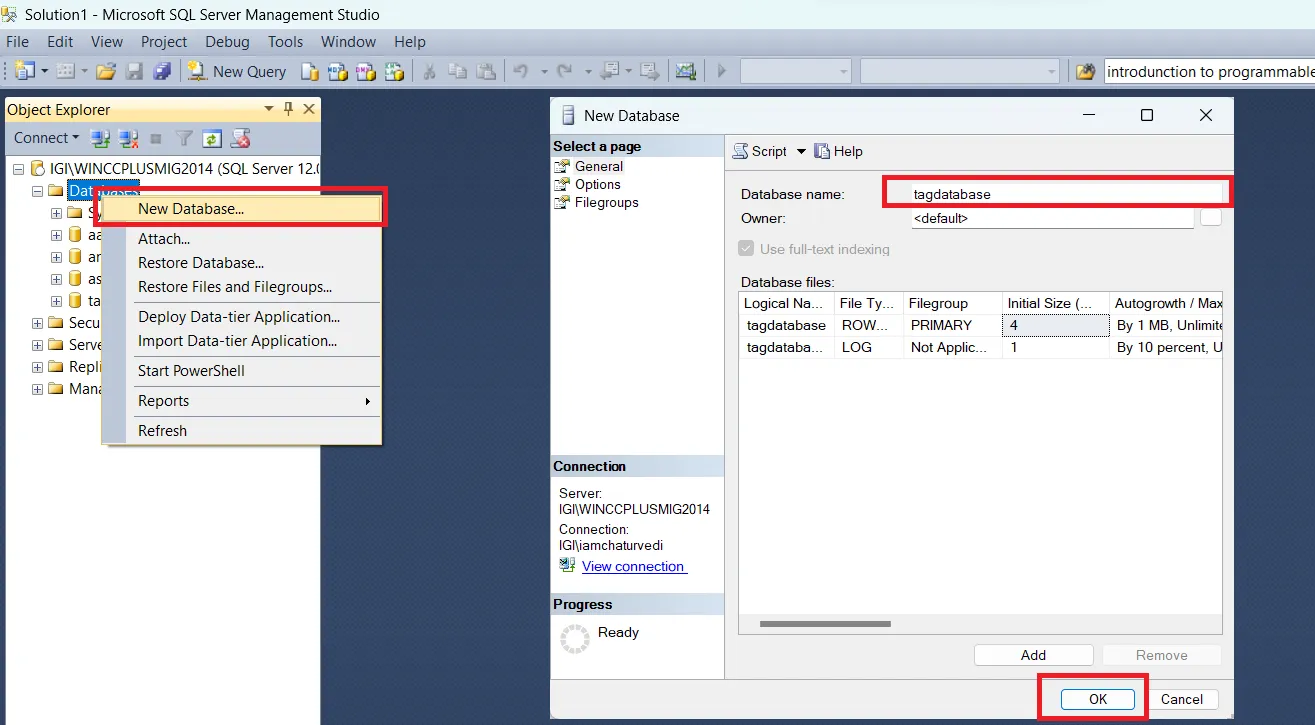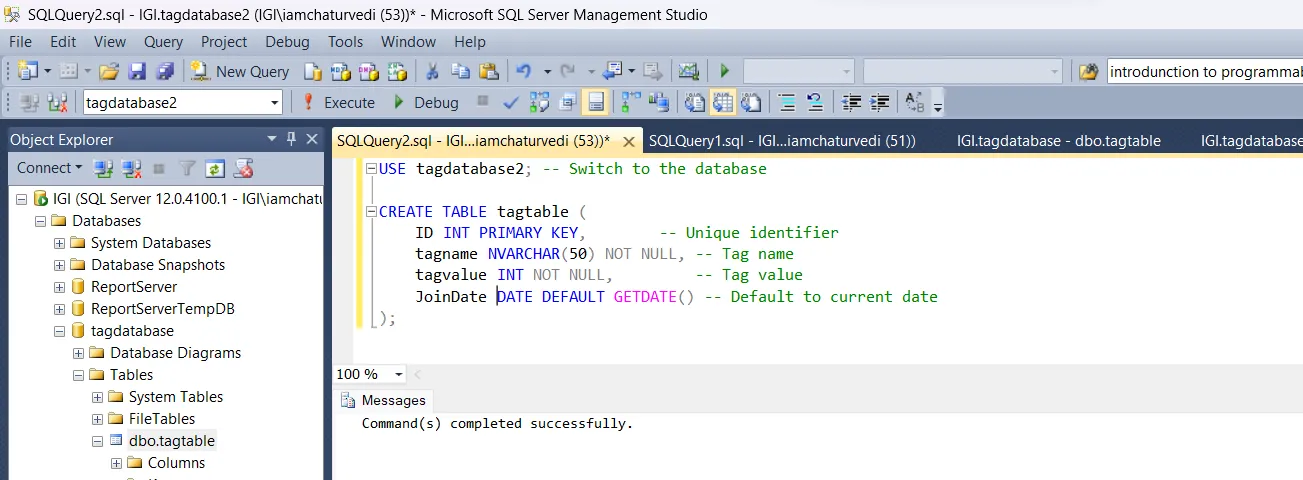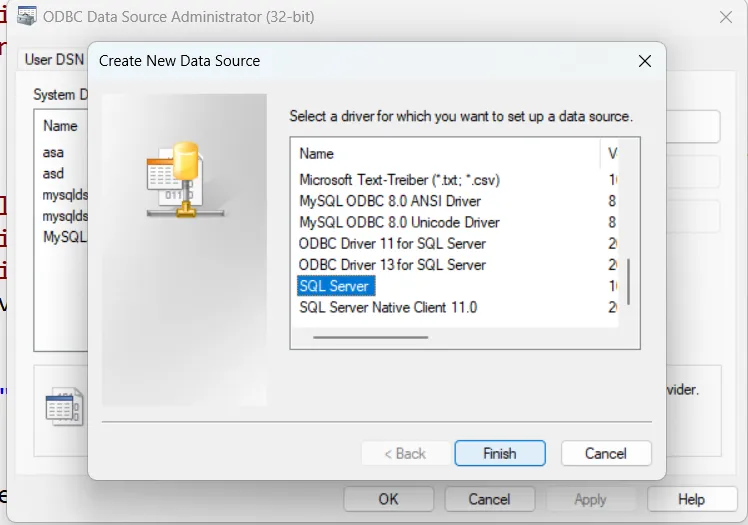VBscript to write and update tag value in MSSQL Database table in Siemens Wincc HMI
Published on Jan07, 2025 | Category: vbscriptShare this Page:
Microsoft SQL Server (MSSQL) is a relational database management system (RDBMS). it stores and retrieves data as request. in MSSQL data organized in table each table have row and column. VBscript in wincc hmi helps to connect MSSQL data base. by using VBscript you can add and update tag value in database table. it helps to retrieves values, data logging, report generation and remote connection of hmi to MSSQL server. vbscript is very simple language to understand. siemens hmi also support vbscript so you can easily connect database with hmi.in this article have example script to add and update tag value. The VBScript function Sub write_value() performs database operations
(insert or update) based on the existence of a record in a SQL database table.
It is designed to work within an HMI (Human-Machine Interface) environment, interacting with a database via ODBC.
what is Microsoft SQL server Management studio
Microsoft SQL Server Management Studio (SSMS) is an integrated environment for managing, configuring, and interacting with SQL Server instances. It is a powerful tool provided by Microsoft for database administrators (DBAs), developers, and analysts to manage databases, write queries, and perform administrative tasks. SSMS is free and can be downloaded from the official Microsoft website.
- OPEN sql server management studio (SSMS) and connect to your SQL Server instance.
- Use your credentials to log in (either Windows Authentication or SQL Server Authentication).

how to create tag database in MSSQL
first step to create tag database to store tag value so we can read and write these tag value. a tag database an organized collection of tag values that can be easily accessed, managed, and updated. You can create database by Using the GUI (Graphical User Interface) or Using SQL Query. follow these steps to create a database in MSSQL. Using the GUI (Graphical User Interface):
- In the Object Explorer, expand the Server node.
- Right-click on the Databases folder.
- Select New Database from the context menu.
- In the New Database window:
- Enter the Database Name (
tagdatabase). - Review or modify settings like file locations or sizes if needed (optional).
- Enter the Database Name (
- Click OK to create the database.

how to create database Using SQL Query:
- Open a new query window by clicking New Query in the toolbar.
- Write the following SQL code:
"CREATE DATABASE tagdatabase2;" - Execute the query by pressing F5 or clicking the Execute button.

how to create tag table in MSSQL
A table in a database is a structured format for storing data. It organizes data into rows and columns, making it easy to manage, retrieve, and manipulate. Tables are a fundamental component of relational databases. you can create table in mssql by using GUI or SQL query
create table Using SQL Queries
- Open a New Query Window:
- In SSMS, click New Query from the toolbar.
- Write a SQL Script:
- Example SQL to create a
Userstable:
USE tagdatabase2; -- Switch to the database CREATE TABLE tagtable ( id INT NOT NULL IDENTITY(1,1) PRIMARY KEY, -- Unique identifier tagname NVARCHAR(50) NOT NULL, -- Tag name tagvalue INT NOT NULL, -- Tag value JoinDate DATE DEFAULT GETDATE() -- Default to current date ); - Example SQL to create a
- Execute the Script:
- Press F5 or click the Execute button to create the table.

how to configure dsn for wincc sql server
A Data Source Name (DSN) is a configuration that provides the necessary information for an application to connect to a database, such as the database driver, server address, and authentication details. DSN commonly stands for Data Source Name, a configuration used in computing to define how an application connects to a database. Step 1: Open ODBC Data Source Administrator
- open control panel
- open windows tools
- Choose the appropriate version of ODBC:
- Use the 32-bit version if your application is 32-bit.
- Use the 64-bit version if your application is 64-bit.

Step 2: Add a New DSN
- In the ODBC Data Source Administrator, go to the System DSN or User DSN tab:
- System DSN: Available to all users on the system.
- User DSN: Available only to the current user.
- Click the Add button.

select driver for DSN

Step 3: Configure the DSN
- In the Create a New Data Source to SQL Server window:
- Enter a name for the DSN (e.g.,
MySql). - Provide an optional description.
- Select the SQL Server instance to connect.
- Enter a name for the DSN (e.g.,
- Click Next.

Step 4: Configure Authentication
- Choose the authentication method:
- Windows Authentication: Uses the current Windows user's credentials.
- SQL Server Authentication: Requires a username and password.
- Click Next.

Step 5: Configure the Default Database
- Select the default database for the DSN from the dropdown menu.
- Click Next.

Step 6: Test the DSN
- Click the Test Data Source button to ensure the DSN is working correctly.
- If the test is successful, click Finish.

open tia portal and create a project
open tia portal and create a project to read and update tag value.first open tag table and add a input1 tag in tag table and select integer data type.

after adding tag in tag table. open screen and then add following component in your screen
- I/O field : add a i/o field and then add input1 tag to items in general property.
- text field : add a text field item for status of vbscript execution
- button : add a button and rename to add. vbscript executed when button is pressed. so add vbscript after compile in button press event property.

VBscript to write and update tag value in MSSQL Database table in Siemens Wincc HMI

above is the example of VBscript to write and update tag value. The script checks if a specific record exists in the database. If it exists, the script updates the record. Otherwise, it inserts a new record. The HMI's text field displays success or error messages during execution.
Sub write_value()Defines the subroutine write_value, which performs database operations.
Variable Declaration
' Variables
Dim conn, strConn, sqlCheck, sqlInsert, sqlUpdate, dsn
Dim valueToInsert
Dim textfield
Dim rs
Declares variables for database connections, SQL queries, HMI fields, and recordset handling.
HMI Text Field Reference
Set textfield = HmiRuntime.Screens("Screen_1").ScreenItems("Text field_1")References the text fieldText field_1onScreen_2in the HMI runtime for status messages.
Define ODBC DSN and Connection String
' ODBC DSN details
dsn = "MySql" ' Replace with your ODBC DSN name
' Connection string using DSN and Windows Authentication
strConn = "DSN=" & dsn & ";Trusted_Connection=Yes;"
Defines the ODBC DSN name and builds the connection string for Windows Authentication.
Define Value to Insert
valueToInsert = SmartTags("input1")Defines the value to be inserted or updated in the database. Replace SmartTags("input1") with the actual value source.
SQL Check Query
sqlCheck = "SELECT COUNT(*) AS RecordCount FROM tagtable WHERE tagname = 'temprature1'"Defines the SQL query to check if a record withtagname = 'temprature1'exists in thetagtable.
Establish Database Connection
' Create the connection object
Set conn = CreateObject("ADODB.Connection")
' Attempt to open the connection
On Error Resume Next
conn.Open strConn
Creates an ADO connection object and attempts to open the database connection.
Check Connection Status
If conn.State = 1 ThenVerifies that the database connection is successfully established (state 1).
Execute SQL Check Query
Set rs = conn.Execute(sqlCheck)Executes the SQL query to check if the record exists and stores the result in rs.
Insert or Update Logic
If rs.Fields("RecordCount").Value > 0 Then
' Update existing record
sqlUpdate = "UPDATE tagtable SET tagvalue = '" & valueToInsert & "' WHERE tagname = 'temprature1'"
conn.Execute sqlUpdate
textfield.Text = "Record updated successfully!"
Else
' Insert new record
sqlInsert = "INSERT INTO tagtable (tagname, tagvalue) VALUES ('temprature1', '" & valueToInsert & "')"
conn.Execute sqlInsert
textfield.Text = "Value inserted successfully into the database!"
End If
Checks if the record exists. If it does, updates the value; otherwise, inserts a new record. Displays a success message in the HMI text field.
Handle Connection Errors
Else
textfield.Text = "Failed to connect to the database."Displays an error message in the HMI text field if the database connection fails.
Cleanup Resources
' Close the connection and clean up
If conn.State = 1 Then conn.Close
Set conn = Nothing
Closes the database connection and releases the connection object to free resources.
End the Subroutine